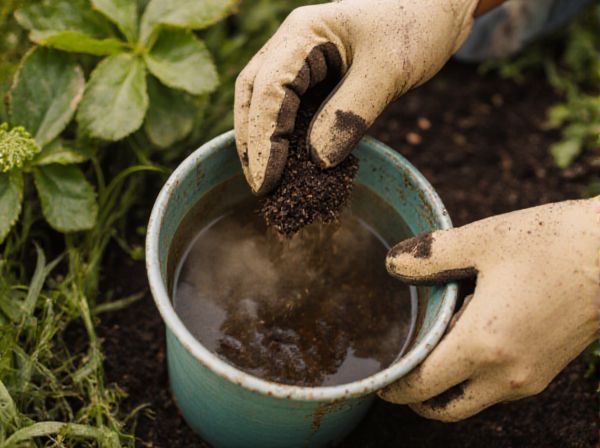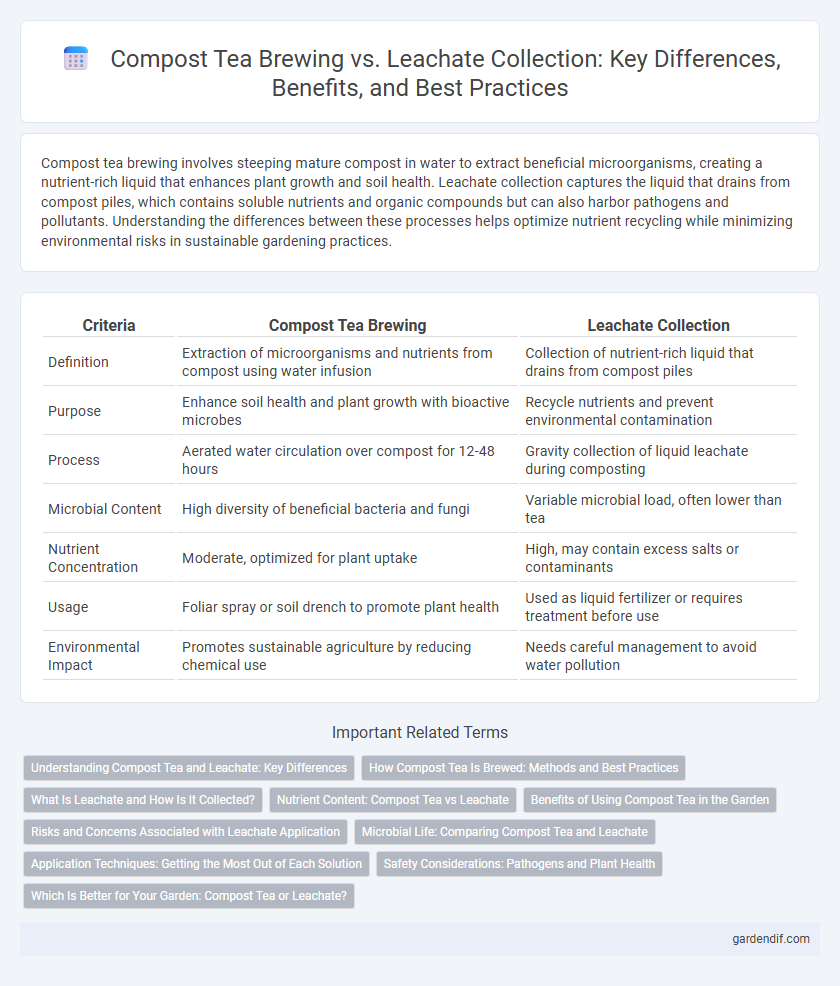
Compost Tea Brewing vs Leachate Collection Illustration
Compost tea brewing involves steeping mature compost in water to extract beneficial microorganisms, creating a nutrient-rich liquid that enhances plant growth and soil health. Leachate collection captures the liquid that drains from compost piles, which contains soluble nutrients and organic compounds but can also harbor pathogens and pollutants. Understanding the differences between these processes helps optimize nutrient recycling while minimizing environmental risks in sustainable gardening practices.
Table of Comparison
| Criteria | Compost Tea Brewing | Leachate Collection |
|---|---|---|
| Definition | Extraction of microorganisms and nutrients from compost using water infusion | Collection of nutrient-rich liquid that drains from compost piles |
| Purpose | Enhance soil health and plant growth with bioactive microbes | Recycle nutrients and prevent environmental contamination |
| Process | Aerated water circulation over compost for 12-48 hours | Gravity collection of liquid leachate during composting |
| Microbial Content | High diversity of beneficial bacteria and fungi | Variable microbial load, often lower than tea |
| Nutrient Concentration | Moderate, optimized for plant uptake | High, may contain excess salts or contaminants |
| Usage | Foliar spray or soil drench to promote plant health | Used as liquid fertilizer or requires treatment before use |
| Environmental Impact | Promotes sustainable agriculture by reducing chemical use | Needs careful management to avoid water pollution |
Understanding Compost Tea and Leachate: Key Differences
Compost tea brewing involves steeping compost in water to extract beneficial microorganisms that enhance soil health and plant growth, whereas leachate collection refers to capturing the nutrient-rich liquid that drains from compost piles, often containing both beneficial nutrients and potential contaminants. Understanding the microbial diversity and oxygenation levels in compost tea is crucial, as it promotes aerobic beneficial microbes, while leachate may harbor anaerobic microbes and pathogens due to limited oxygen exposure. These differences impact application methods and environmental safety, making it essential to distinguish between the biologically active, plant-growth-promoting tea and the nutrient-leaching, potentially hazardous leachate.
How Compost Tea Is Brewed: Methods and Best Practices
Compost tea is brewed through aerobic extraction, using oxygenated water to steep mature compost and release beneficial microorganisms into the liquid. Common methods include actively aerated compost tea (AACT) systems that employ pumps and diffusers to maintain oxygen levels, ensuring microbial diversity and activity remain high. Best practices emphasize using high-quality, pathogen-free compost, maintaining optimal brewing temperatures between 20-25degC, and limiting brew time to 24-36 hours to maximize microbial growth while preventing harmful anaerobic conditions.
What Is Leachate and How Is It Collected?
Leachate is the nutrient-rich liquid that drains from compost piles during the decomposition process, containing soluble organic compounds, minerals, and microorganisms. It is collected by placing impermeable liners or drainage systems beneath compost piles, which channel the leachate into storage tanks or treatment facilities to prevent environmental contamination. Proper leachate collection is essential for managing waste liquids, reducing odors, and recycling nutrients back into soil or composting systems.
Nutrient Content: Compost Tea vs Leachate
Compost tea brewing produces a nutrient-rich liquid teeming with beneficial microorganisms, enhancing soil health and plant growth through bioavailable nutrients like nitrogen, phosphorus, and potassium. In contrast, leachate collection from compost piles often contains high concentrations of soluble nutrients and potential contaminants, posing a risk of nutrient leaching and environmental pollution if not managed properly. The nutrient content in compost tea is more balanced and targeted for agricultural use, whereas leachate nutrient levels can vary widely depending on compost composition and moisture conditions.
Benefits of Using Compost Tea in the Garden
Compost tea enriches soil with beneficial microorganisms that enhance nutrient availability and promote plant growth, improving overall garden health. This aerobic brew suppresses harmful pathogens and stimulates soil microbial diversity, leading to stronger, more resilient plants. Unlike leachate collection, compost tea application is targeted and eco-friendly, maximizing nutrient uptake without environmental contamination.
Risks and Concerns Associated with Leachate Application
Leachate from compost contains high concentrations of nitrates, pathogens, and heavy metals that pose significant environmental and public health risks if applied to soil without adequate treatment. Its uncontrolled application can lead to groundwater contamination, eutrophication of nearby water bodies, and increased exposure to harmful microorganisms. Monitoring and proper management are essential to minimize leachate runoff and prevent soil degradation and human health hazards.
Microbial Life: Comparing Compost Tea and Leachate
Compost tea brewing actively cultivates diverse microbial populations by aerating water with compost, enhancing beneficial bacteria, fungi, and protozoa critical for soil health and plant growth. Leachate collection, on the other hand, captures nutrient-rich liquid that contains microbes but often lacks the same microbial diversity and aerobic activity found in compost tea. The intensified microbial life in compost tea promotes pathogen suppression and nutrient cycling, distinguishing it from the typically anaerobic, less biologically active leachate.
Application Techniques: Getting the Most Out of Each Solution
Compost tea brewing enhances soil microbiology by extracting beneficial microorganisms through controlled aeration and nutrient infusion, promoting plant health when applied as a foliar spray or soil drench. Leachate collection captures nutrient-rich liquid runoff during composting, which can be diluted and applied as a concentrated fertilizer to improve soil nutrient availability. Optimizing these techniques involves tailoring application frequency and concentration based on crop needs, environmental conditions, and compost maturity to maximize nutrient uptake and microbial activity.
Safety Considerations: Pathogens and Plant Health
Compost tea brewing requires careful management to prevent the proliferation of pathogens such as E. coli and Salmonella, which can pose risks to both human health and plants. Leachate collection involves capturing nutrient-rich water that may contain harmful microbes, necessitating proper treatment to avoid pathogen spread and protect plant health. Ensuring aerobic conditions and monitoring microbial populations during compost tea production and leachate handling are critical safety practices to minimize pathogen contamination and promote plant growth.
Which Is Better for Your Garden: Compost Tea or Leachate?
Compost tea brewing involves aerating water with compost to extract beneficial microbes, enhancing soil fertility and plant health through microbial inoculation. Leachate collection captures nutrient-rich liquid draining from compost, providing concentrated organic nutrients but with potential phytotoxic risks if not properly managed. For garden applications, compost tea offers a balanced microbial boost promoting sustainable soil ecosystems, whereas leachate serves best as a targeted nutrient supplement requiring careful dilution and monitoring.
Compost Tea Brewing vs Leachate Collection Infographic

 gardendif.com
gardendif.com